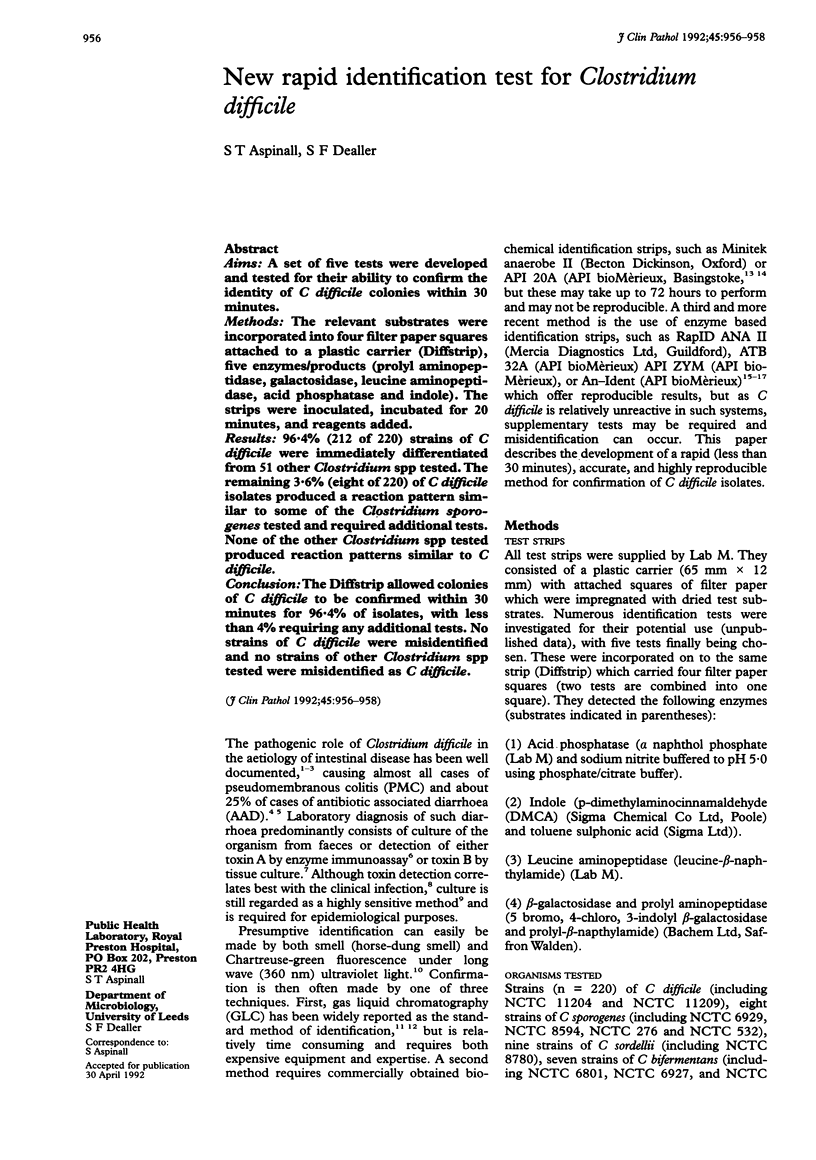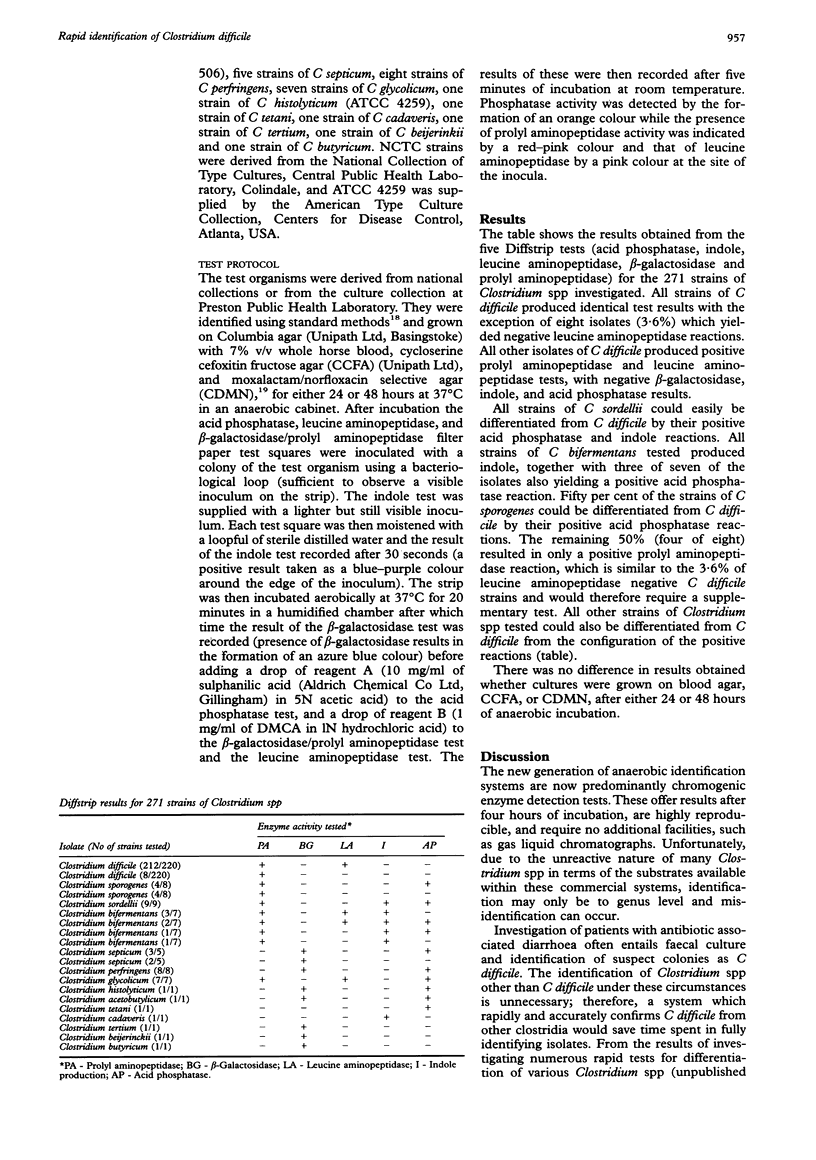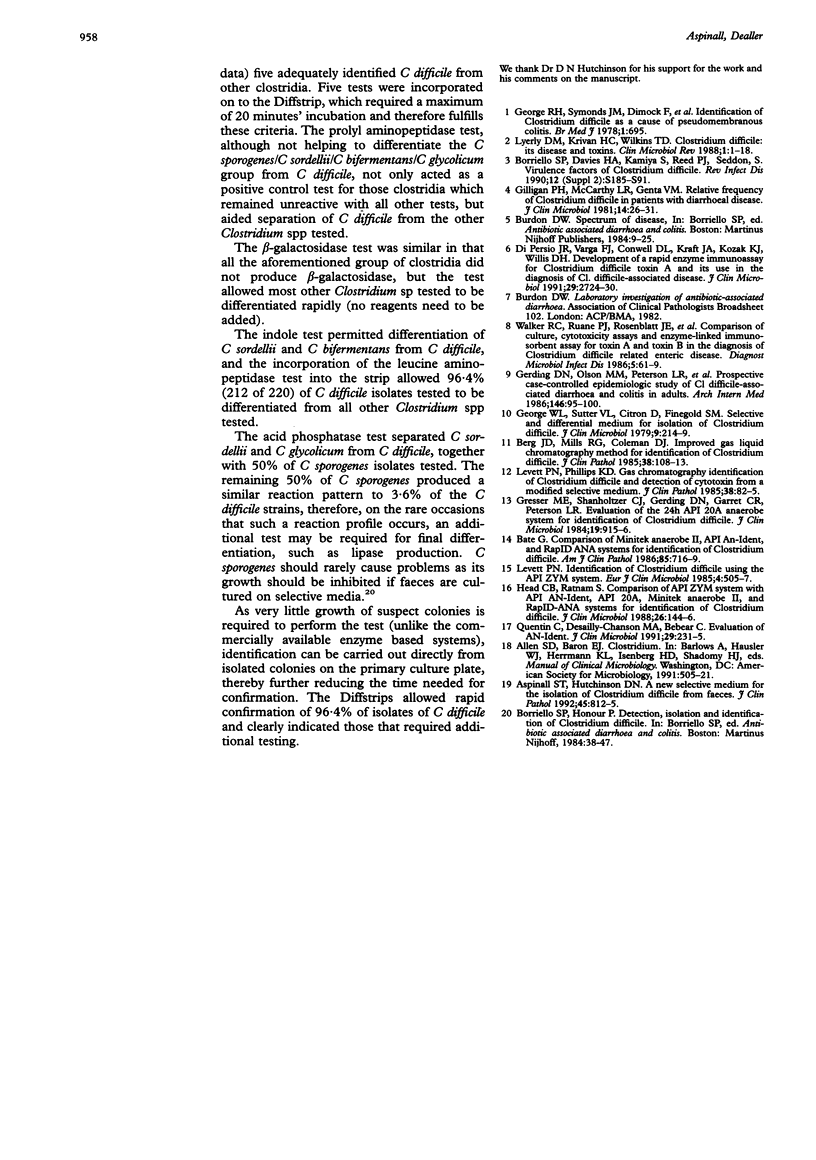Abstract
AIMS: A set of five tests were developed and tested for their ability to confirm the identity of C difficile colonies within 30 minutes. METHODS: The relevant substrates were incorporated into four filter paper squares attached to a plastic carrier (Diffstrip), five enzymes/products (prolyl aminopeptidase, galactosidase, leucine aminopeptidase, acid phosphatase and indole). The strips were inoculated, incubated for 20 minutes, and reagents added. RESULTS: 96.4% (212 of 220) strains of C difficile were immediately differentiated from 51 other Clostridium spp tested. The remaining 3.6% (eight of 220) of C difficile isolates produced a reaction pattern similar to some of the Clostridium sporogenes tested and required additional tests. None of the other Clostridium spp tested produced reaction patterns similar to C difficile. CONCLUSION: The Diffstrip allowed colonies of C difficile to be confirmed within 30 minutes for 96.4% of isolates, with less than 4% requiring any additional tests. No strains of C difficile were misidentified and no strains of other Clostridium spp tested were misidentified as C difficile.
Full text
PDF


Selected References
These references are in PubMed. This may not be the complete list of references from this article.
- Aspinall S. T., Hutchinson D. N. New selective medium for isolating Clostridium difficile from faeces. J Clin Pathol. 1992 Sep;45(9):812–814. doi: 10.1136/jcp.45.9.812. [DOI] [PMC free article] [PubMed] [Google Scholar]
- Bate G. Comparison of Minitek Anaerobe II, API An-Ident, and RapID ANA systems for identification of Clostridium difficile. Am J Clin Pathol. 1986 Jun;85(6):716–718. doi: 10.1093/ajcp/85.6.716. [DOI] [PubMed] [Google Scholar]
- Berg J. D., Mills R. G., Coleman D. J. Improved gas-liquid chromatography method for the identification of Clostridium difficile. J Clin Pathol. 1985 Jan;38(1):108–110. doi: 10.1136/jcp.38.1.108. [DOI] [PMC free article] [PubMed] [Google Scholar]
- Borriello S. P., Davies H. A., Kamiya S., Reed P. J., Seddon S. Virulence factors of Clostridium difficile. Rev Infect Dis. 1990 Jan-Feb;12 (Suppl 2):S185–S191. doi: 10.1093/clinids/12.supplement_2.s185. [DOI] [PubMed] [Google Scholar]
- DiPersio J. R., Varga F. J., Conwell D. L., Kraft J. A., Kozak K. J., Willis D. H. Development of a rapid enzyme immunoassay for Clostridium difficile toxin A and its use in the diagnosis of C. difficile-associated disease. J Clin Microbiol. 1991 Dec;29(12):2724–2730. doi: 10.1128/jcm.29.12.2724-2730.1991. [DOI] [PMC free article] [PubMed] [Google Scholar]
- George R. H., Symonds J. M., Dimock F., Brown J. D., Arabi Y., Shinagawa N., Keighley M. R., Alexander-Williams J., Burdon D. W. Identification of Clostridium difficile as a cause of pseudomembranous colitis. Br Med J. 1978 Mar 18;1(6114):695–695. doi: 10.1136/bmj.1.6114.695. [DOI] [PMC free article] [PubMed] [Google Scholar]
- George W. L., Sutter V. L., Citron D., Finegold S. M. Selective and differential medium for isolation of Clostridium difficile. J Clin Microbiol. 1979 Feb;9(2):214–219. doi: 10.1128/jcm.9.2.214-219.1979. [DOI] [PMC free article] [PubMed] [Google Scholar]
- Gerding D. N., Olson M. M., Peterson L. R., Teasley D. G., Gebhard R. L., Schwartz M. L., Lee J. T., Jr Clostridium difficile-associated diarrhea and colitis in adults. A prospective case-controlled epidemiologic study. Arch Intern Med. 1986 Jan;146(1):95–100. [PubMed] [Google Scholar]
- Gilligan P. H., McCarthy L. R., Genta V. M. Relative frequency of Clostridium difficile in patients with diarrheal disease. J Clin Microbiol. 1981 Jul;14(1):26–31. doi: 10.1128/jcm.14.1.26-31.1981. [DOI] [PMC free article] [PubMed] [Google Scholar]
- Gresser M. E., Shanholtzer C. J., Gerding D. N., Garrett C. R., Peterson L. R. Evaluation of the 24-h API 20A anaerobe system for identification of Clostridium difficile. J Clin Microbiol. 1984 Jun;19(6):915–916. doi: 10.1128/jcm.19.6.915-916.1984. [DOI] [PMC free article] [PubMed] [Google Scholar]
- Head C. B., Ratnam S. Comparison of API ZYM system with API AN-Ident, API 20A, Minitek Anaerobe II, and RapID-ANA systems for identification of Clostridium difficile. J Clin Microbiol. 1988 Jan;26(1):144–146. doi: 10.1128/jcm.26.1.144-146.1988. [DOI] [PMC free article] [PubMed] [Google Scholar]
- Levett P. N. Identification of Clostridium difficile using the API ZYM system. Eur J Clin Microbiol. 1985 Oct;4(5):505–507. doi: 10.1007/BF02014434. [DOI] [PubMed] [Google Scholar]
- Levett P. N., Phillips K. D. Gas chromatographic identification of Clostridium difficile and detection of cytotoxin from a modified selective medium. J Clin Pathol. 1985 Jan;38(1):82–85. doi: 10.1136/jcp.38.1.82. [DOI] [PMC free article] [PubMed] [Google Scholar]
- Lyerly D. M., Krivan H. C., Wilkins T. D. Clostridium difficile: its disease and toxins. Clin Microbiol Rev. 1988 Jan;1(1):1–18. doi: 10.1128/cmr.1.1.1. [DOI] [PMC free article] [PubMed] [Google Scholar]
- Quentin C., Desailly-Chanson M. A., Bebear C. Evaluation of AN-Ident. J Clin Microbiol. 1991 Feb;29(2):231–235. doi: 10.1128/jcm.29.2.231-235.1991. [DOI] [PMC free article] [PubMed] [Google Scholar]
- Walker R. C., Ruane P. J., Rosenblatt J. E., Lyerly D. M., Gleaves C. A., Smith T. F., Pierce P. F., Jr, Wilkins T. D. Comparison of culture, cytotoxicity assays, and enzyme-linked immunosorbent assay for toxin A and toxin B in the diagnosis of Clostridium difficile-related enteric disease. Diagn Microbiol Infect Dis. 1986 May;5(1):61–69. doi: 10.1016/0732-8893(86)90092-1. [DOI] [PubMed] [Google Scholar]


